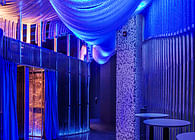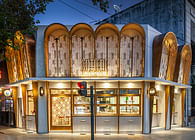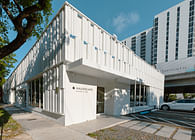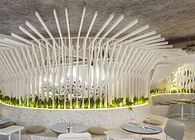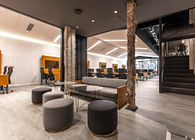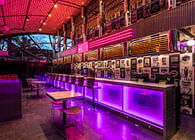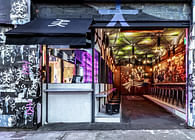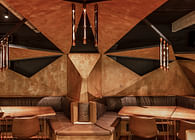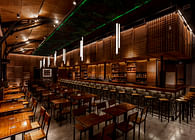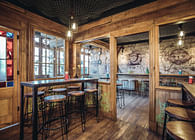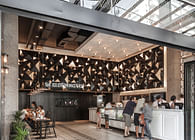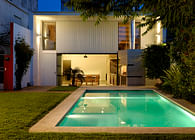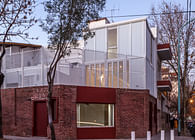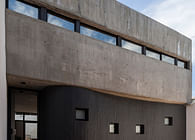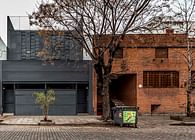
Buenos Aires
The building is located on Niceto Vega Street, an artery in constant development in the Palermo
neighborhood. Being always aware of the location, we always understood the importance of the
building´s presence both from the perspective of both the architectonic and programmatic mark
it leaves.
The speed and lights that characterize this street along with other decisive premises were
analyzed when studying the proposal as a departing point to reflect upon the duality between
the building proposal from its façade to the outside and that from to the inside. We therefore
worked to develop the idea of the façade as an inflection point between the inner spatial search
related to the static-perceptive, and the outer search that expresses the language of the
dynamic, one that is totally linked to vehicular dynamism.
Starting from the decision to preserve the house´s most genuine characteristics (typically
“Palermesque”) the project proposes an integration with the already existent but linking itself
through the modern and contemporary while also paying homage to the original construction.
We were interested from the very beginning in reinterpreting the relation between the façade
and the outside almost like a “back-light” sign operation so as to create a tension, movement,
ludic dynamic, an intention of colors as an answer to the outer reality. Such operation of an
agile, light and modern façade rests on the robustness and solidity of the original façade,
composing a whole that is intimately related and tectonic.
As a result we have the sequence of twelve 13.77 ft. tall x 23.6 in. slender pivoting shutters
made of frosted polycarbonate placed in metal frames, which allow the versatility in the façade
opening, sweeping the specter from an A phase (a 100% hermetically sealed façade) to a B
phase (a totally open façade). Each shutter hides a system of Leds RGB that allows to dye the
façade according to the desired color and chromatic sequence.
This whole dispositive of such a contemporary style provides the final touch to the classic façade
while simultaneously distinguishing itself from it through a visible strip of reinforced concrete
that covers the front side to side.
Inner motionlessness as a contrast
The building functions in cuts, which was achieved through a succession of stepped patios and
floating mezzanines and of quiet spaces for perception and contemplation. Inner spaces
interrelated through continuous visuals that are deliberately aimed at the outside and the main
sources of light, the search for the sky and the green, all of it achieved via the total opening of
space through windows totally devoid of studs and woodwork. Metal frames were designed to
embrace the big glass slabs while avoiding the reinforced concrete structure, forming the whole
inner façade of the building.
The sole idea of focusing and structuring the building towards its inner world resulted in the
capturing of an oasis full of vegetation and making it an integral part of the whole so as to
somehow preserve the essence and character of the original construction.
Throughout the whole work there is the near-obsessive premise of working on the common links
between the “old house” and the “new work”. These links are always points of tension from the
architectonic perspective, which undoubtedly required our utmost attention, reflection and
project solving skills. These encounters between the “old” and “new” worlds demand a particular
care (design and material-wise) for both the general and primary decisions on the project as well
as for the solving of the tiniest construction details
From the technological perspective the project follows the same premise. The construction
functions as an early 20th century house that assimilates the highest technology: from earthfriendly
air conditioning systems to areas with HD audio and video.
As project designers, from the first sketches we became interested in achieving this task by
following the idea of richness of space, the use of noble materials, constructive honesty,
chromatic serenity and the preservation of green so as to achieve a receptacle meant to relegate
all of its prominence to the pieces of art it will contain.
Status: Built
Location: Buenos Aires, AR
Firm Role: Project, design and construction
Additional Credits: Project
HM.Arquitectos _ Fernando Hitzig & Leonardo G. Militello
Direction
Arq. Fernando Hitzig
Collaborators
Juliana Zorza, Lucía Stafforini, Rubén Ruiz
Consultants
Structural engineer: Carlos Gandini
Lighting Consultan: Mauricio Meta ( Estudio Veñares)
Photography
Federico Kulekdjian
Area
Total Covered Surface: 253,3 m2 - Total Un-Covered Surface: 52,1 m2
Program
Art Gallery + Workspace
Promoter
Rincones del arte SRL
